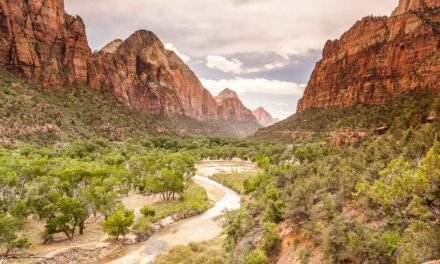Discover the Fascinating Wildlife of Zion National Park
Nestled in southwestern Utah, Zion National Park boasts some of the most diverse and captivating wildlife in the United States. This wondrous park attracts millions of visitors each year who come to admire its soaring red cliffs, narrow canyons, and the mesmerizing array of flora and fauna that call this remarkable landscape home. In this visitor’s guide, we will delve into the most iconic and popular species found in the park and discuss how the wildlife activity changes with the seasons.
Marvel at the Magnificent Mule Deer
One of the most iconic animals of Zion National Park, the mule deer (Odocoileus hemionus), can be found throughout the park, from the lush canyon floors to the high plateaus. Known for their impressive, forked antlers and large, mule-like ears, these gentle herbivores are a common sight during the early morning and evening hours as they forage for food.
Spring and fall are the best times to observe mule deer in the park, as the animals are more active and the temperatures are milder. Keep a lookout for fawns in the late spring and early summer, as they are often seen accompanying their mothers.
Spot the Elusive Mountain Lion
As the top predator in Zion National Park, the mountain lion (Puma concolor) is a captivating yet elusive creature that few visitors have the opportunity to see in the wild. Also known as the cougar or puma, these large cats prefer the park’s remote, rocky terrain, where they hunt deer and other smaller prey.
Although sightings are rare, the chances of encountering a mountain lion increase during the winter months, when the animals are more likely to venture into lower elevations in search of food. Always keep a safe distance and adhere to the park’s guidelines for wildlife encounters.
Witness the Grandeur of Golden Eagles and California Condors
Bird enthusiasts will be thrilled to know that Zion National Park is home to numerous species of birds, including the magnificent golden eagle (Aquila chrysaetos) and the endangered California condor (Gymnogyps californianus). The golden eagle, a powerful predator with a wingspan of up to 7 feet, can often be seen soaring above the park’s open spaces, hunting for small mammals.
The California condor, with its striking black and white plumage and a wingspan of up to 9.5 feet, is one of the rarest birds in North America. Once on the brink of extinction, their populations have increased through extensive conservation efforts. The best time to spot these majestic birds in Zion is during the spring and summer months.
Admire the Playful Desert Bighorn Sheep
No trip to Zion National Park is complete without catching a glimpse of the nimble desert bighorn sheep (Ovis canadensis nelsoni). These animals are specially adapted to the rugged terrain and dry climate of the park, with their impressive climbing abilities and keen eyesight. The sheep are often seen scaling the steep cliffs or resting on rocky outcrops.
While desert bighorn sheep can be observed year-round, visitors are more likely to encounter them during the cooler months, when they descend to lower elevations. In the fall, you may witness the exciting head-butting displays of rams competing for dominance.
Discover the Smaller Inhabitants of Zion National Park
In addition to its larger, more conspicuous inhabitants, Zion National Park is also home to a multitude of smaller creatures that contribute to the park’s rich biodiversity. From tiny reptiles to colorful insects, these often-overlooked inhabitants play a crucial role in the park’s ecosystem.
Observe the Vibrant Life of Reptiles and Amphibians
Zion National Park’s diverse habitats provide a haven for various species of reptiles and amphibians. Among them, the Great Basin collared lizard (Crotaphytus bicinctores) stands out for its striking coloration and unique, almost dinosaur-like appearance. The park’s numerous rocky outcrops and scrublands are perfect habitats for these agile reptiles, which are most active during the warmer months.
Another interesting resident is the canyon tree frog (Hyla arenicolor), a small amphibian that has adapted to the arid environment by blending in with its surroundings. Their cryptic coloration makes them difficult to spot, but keen-eyed visitors might find them resting on rocks near streams and pools, particularly during the spring and summer months.
Delight in the Diverse World of Zion’s Insects
Zion National Park is home to a fascinating array of insects, with some of the most eye-catching species being the butterflies and moths. The stunning two-tailed swallowtail (Papilio multicaudata), for example, is known for its striking yellow and black pattern and elongated tail-like extensions on its hind wings. These butterflies are commonly seen during the summer months, fluttering gracefully in the park’s meadows and along the trails.
Another intriguing insect found in Zion is the giant silk moth (Hyalophora columbia), one of the largest moths in North America. With its distinct reddish-brown coloration and a wingspan of up to 6 inches, this nocturnal creature is a sight to behold. The adult moths are active during the warm summer nights, while their distinctive, furry caterpillars can be found on trees and shrubs in the late spring and summer.
Experience the Wildlife of Zion National Park Across the Seasons
Zion National Park’s varied landscapes and habitats support a remarkable array of wildlife that changes with the seasons. Whether you’re visiting in the heat of the summer or the chill of the winter, the park’s flora and fauna offer a wealth of opportunities for exploration and discovery. By learning about the park’s most iconic and popular species, you’ll gain a deeper appreciation for the incredible biodiversity that makes Zion National Park a truly unforgettable destination.


